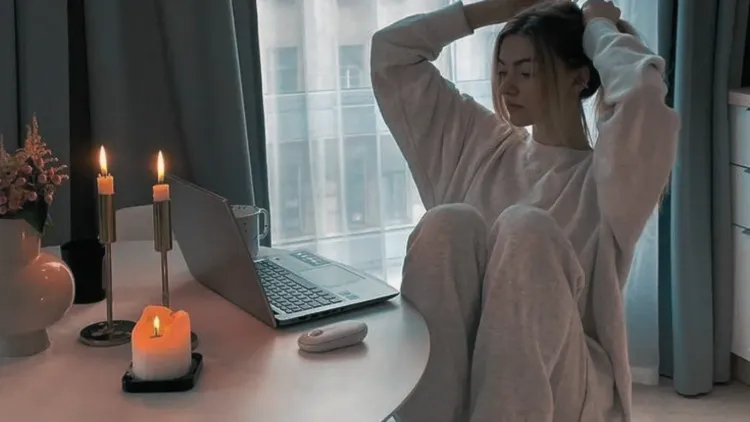
Impostor Syndrome: How to Face Your Inner Critic Before It Becomes Your Biggest Nightmare
It’s that time of year again. The leaves are turning, the coffee is spiced, and we’re all getting ready to put on a mask. Whether it’s a perfectly curated Halloween costume or the other mask—the one we wear in the boardroom, in the pitch meeting, or at a networking event—this season is a potent reminder of the gap between how we feel on the inside and how we present ourselves to the world.
For the modern working woman, that gap often has a name: Imposter Syndrome.
It’s the silent, chilling companion that sits under the desk, whispering, "You don't belong here. They're going to find out. You just got lucky." It’s the feeling that every achievement is a fluke, every promotion is a clerical error, and any minute now, the metaphorical curtain is going to be pulled back to reveal the chaotic, underqualified reality that is you.
I know the feeling intimately. I’ve been there—nailing a huge project and then immediately feeling sick with the anxiety that I’d never be able to replicate the success. It’s like being trapped in a horror movie where the monster isn't a zombie or a ghost, but a hyper-critical version of yourself, constantly trying to sabotage your peace of mind.
This Halloween, we’re not just going to dress up; we’re going to get strategic. We’re going to stop trying to silence the monster and, instead, learn how to unmask its claims. Imposter Syndrome affects an estimated 70% of successful individuals at some point, and it’s especially cruel to high-achieving women. It’s not a personality flaw; it’s a psychological response to success, and understanding that is our first step toward turning fear into fuel.
How To Identify Your Inner Critic
The key to conquering any fear is knowing its source. The genius of Imposter Syndrome is that it uses your voice to scare you. It wears the costume of self-doubt, but its real power lies in its ability to distort your reality.

The problem with the Imposter Syndrome Industrial Complex (as I like to call it) is that it makes us think we need to do more, achieve more, and be more perfect to get rid of the feeling. Just like with the mythical influencer morning routine that demands we wake up at 5 AM to achieve flawless enlightenment, the cure for Imposter Syndrome is often sold as more hustle.
But the truth is, the more you achieve, the louder the monster often screams. Why? Because the stakes keep getting higher.
The Psychology of the Imposter: Why We Create Our Own Fears
The term Imposter Phenomenon was coined in the 1970s by psychologists Dr. Pauline Rose Clance and Dr. Suzanne Imes. They initially focused on high-achieving women who, despite overwhelming external evidence of their competence, still felt like frauds. The core belief is this: "If I’m smart/successful, it must be because I'm hardworking, not because I'm naturally brilliant." This leads to a cycle of over-preparation, anxiety, temporary relief from a successful outcome, and then immediately discounting the success.
We create our own monster because, sociologically, women are often praised for effort and perfection rather than innate capability. We’re often told, implicitly or explicitly, that our success is conditional. When we internalize that, any moment of success is discounted as a lucky break rather than deserved recognition.
Your Inner Critic’s Core Lies:
- "It was a fluke." (It was luck, not skill.)
- "Everyone else knows more than me." (The fear of being exposed as the least knowledgeable person in the room.)
- "I need to be perfect every time." (A minor mistake confirms the "imposter" status.)
Recognizing these lies is like turning on the light in the dark hallway. Once you see the monster is just a shadow cast by your own anxiety, it immediately loses its power. But seeing it is just the start; the real work is in the unmasking.
Taking Off the Mask: Separating Yourself from Your Self-Doubt
The most effective way to confront the inner critic isn't to argue with it, but to outsource it. We need a system, a ritual, to take the thoughts swirling in our heads—the to-do lists, the anxious concerns, and the damning self-critiques—and give them a designated space outside of our mental real estate.
The 'Show Me the Data' Approach: Fact-Checking Your Feelings
The Inner Critic is a creature of emotion, not logic. It deals in generalized feelings of inadequacy. Your job is to bring facts to the table. This is the most crucial step for any working woman, because in your professional life, you deal in data, outcomes, and metrics.
When the monster whispers, “You completely botched that presentation, everyone thinks you’re disorganized,” your gut reaction is to agree. But a CEO doesn't agree with gut feelings; she looks at the data.
The Evidence File Method
Keep a simple document, folder, or notebook (digital or physical) called "The Evidence File." This is where you store proof that directly contradicts the Imposter’s claims.
- Positive Feedback: Every "Great job!" email, every compliment on a project, every successful performance review comment. Copy and paste it in.
- Accomplishments, Not Tasks: Don't list what you did (e.g., "sent 10 emails"). List the outcome (e.g., "Secured a new client with a 20% budget increase").
- Skills Acquired: Note every new certification, skill learned, or software mastered.
The next time the inner critic attacks, you don’t engage in a verbal debate. You simply say, “Show me the data.” Then, open the file and read three entries. You are using your proven track record to literally fact-check your temporary, negative emotion. The monster can’t survive in the face of hard evidence.
The Spooky Season Toolkit: Rituals to Confront Your Fear
As we saw with the brain dump method for clearing your mind before bed, the simple act of writing things down is incredibly powerful. We’re going to adapt that practice specifically for the inner critic.
The "Monster’s Letter" Ritual:
- At the end of a particularly self-critical day, dedicate 10 minutes to this ritual. Get a piece of paper and a pen.
- Title the page, “What the Imposter Wants Me to Believe Today.” Dump every single, chaotic, self-deprecating thought onto the page. I am not ready for the promotion. My boss is disappointed in me. I shouldn't have spoken up in that meeting. My idea was stupid. Don't edit. Write until the page is full or the thoughts stop flowing.
- Now, read each statement and assign it to one of two columns:
- Fact (F): Did my boss actually tell me they were disappointed? Did I receive a negative performance review? (Almost always no.)
- Feeling/Fear (FF): Is this just a feeling of being disappointed in myself? Is this a fear of a future outcome? (Almost always yes.)
- Once you've separated the facts from the fears, dispose of the paper. You can rip it up, delete the file, or, to embrace the season, even burn it (safely, of course!). You are symbolically releasing the fears from your mental space. They are no longer your burden; they are just ink on paper, and now they are gone.
This ritual works because it externalizes the anxiety. You are no longer being the inner critic; you are observing it. This separation is the true key to freedom.
Re-Writing Your Internal Narrative for Success

Confronting Imposter Syndrome isn’t just about putting out fires; it’s about strategically re-building the foundation of how you view your own competence.
The Five Faces of the Imposter: Knowing Your Specific Monster
The Imposter Syndrome experience isn't monolithic. Dr. Valerie Young, an expert on the subject, breaks it down into five distinct types. Identifying which mask your monster wears allows you to target your defenses.
- The Perfectionist: Sets impossibly high standards and feels like a failure if they don’t meet 100% of them. Defense: Practice "good enough" instead of perfect. Focus on completion over optimization.
- The Superwoman/Man: Overworks themselves to prove their worth, equating hustle with competence. Defense: Learn to delegate. Acknowledge that your value is tied to your results, not your hours.
- The Natural Genius: Believes they should master everything quickly and easily. Struggles with things that require effort or a learning curve. Defense: Reframe struggle as growth. Embrace the process of learning and needing help.
- The Soloist: Believes they must accomplish everything on their own and sees asking for help as a sign of weakness or fraudulence. Defense: Practice collaboration. Ask one strategic question per week to your team or mentor.
- The Expert: Focuses on constantly accumulating knowledge and is terrified of being exposed if they don't know the answer to every question. Defense: Embrace the role of an informed leader. Leaders ask the right questions, they don't have all the answers.
When you label your specific "monster," you strip it of its mystique. You realize it’s a specific, predictable pattern of thought, not an all-encompassing truth about your character.
The Confidence Coven: Why You Need to Talk About the Monster
One of the most insidious tricks of Imposter Syndrome is that it thrives in silence and isolation. It makes you feel like you are the only one who is faking it.
Your secret weapon—your Confidence Coven—is your network of peers, mentors, and friends. These are the people who will hold up the mirror for you when you can’t see your own reflection clearly.
Actionable Steps for Building Your Coven:
- Start the Conversation: Next time you’re with a trusted colleague, don't just ask about their work; ask about their challenges. A simple, "What's a project you really struggled with but overcame?" is often enough to open the door.
- Vulnerability as Power: Use your own experience to normalize the feeling. Sharing a moment where you felt out of your depth, only to realize you handled it, gives others permission to be honest, too.
- The Power of External Validation: When a Coven member is struggling, don't offer empty encouragement. Remind them of a specific, tangible achievement they accomplished. “Remember that impossible deadline you crushed last month? That’s what I mean when I say you can handle this.”
The true magic happens when you realize that all the women you look up to—the ones who seem to have it all together—have their own inner critics, too. The difference is they’ve learned to recognize the monster’s voice and refuse to let it run the show.
Don’t Let the Costume Define You: The Final Takeaway
Halloween is about the illusion of transformation—a fun night of playing dress-up. But your career and your competence are not an illusion. They are built on years of late nights, hard choices, and documented wins.
The goal isn't to eradicate Imposter Syndrome completely—that’s like trying to wish away your shadow. The shadow will always be there, but it only seems monstrous when you’re facing away from the light.
Your job as a successful working woman is to keep facing the light: keep documenting your wins, keep sharing your struggles with your Coven, and keep creating rituals that separate your fears from your facts. Your inner critic is just a reflection of your ambition; it's the part of you that cares deeply about the quality of your work.
So, this spooky season, take off the mask you feel forced to wear. The only person you need to convince is yourself. Unmask the lies, embrace the power of your actual track record, and remind yourself that the real you—the one who works hard, is continually learning, and is capable of incredible things—is far more impressive than any costume or character you could ever invent.
### Listen to The Working Gal Podcast Episode, How to Build Confidence, According to Science, on Spotify or YouTube.






